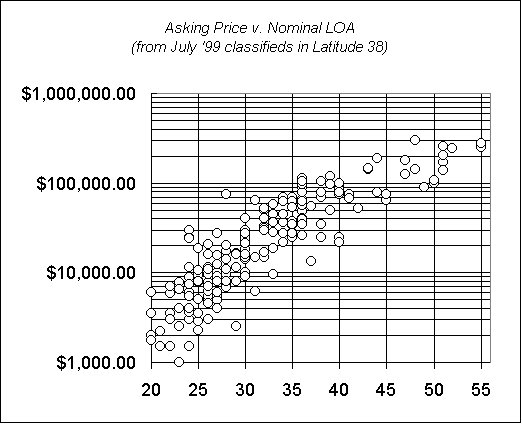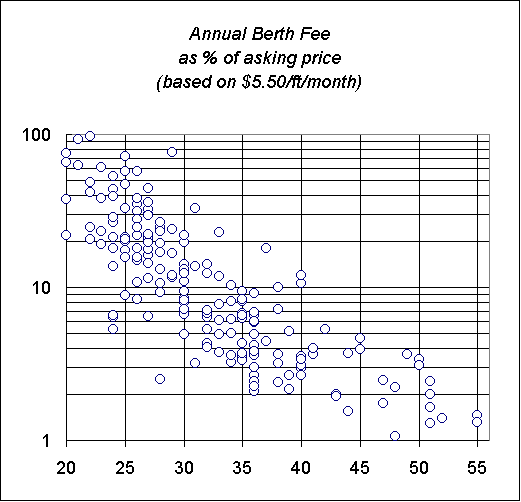

by Paul Kamen
Waterfront Commission
April 21, 1999
This proposal represents a significant structural change to the berth rates in the Berkeley Marina. It is designed to make the rate structure easy to administer and easy to understand and describe. Most importantly, this proposal is designed to set rates that better reflect the market forces that control the demand for various categories of berthing.
The most significant change is the more "progressive" variation in berth rates as the size category increases. This is to reflect the fact that boat costs increase very rapidly with size, approximately by size to the 3.5 power or more. For example, a 40 foot boat is likely to cost more than ten times as much to own and operate as a 20 foot boat. The result of this cost curve is that berth fees are very much more significant for small boats, and of decreasing consequence for larger boats. The small boat owner is far more likely to shop price when choosing a marina. The owner of the larger boat sees berthing as a less significant expense, and the choice of marina is more likely to be driven by non-economic factors.
 |
This graph shows the exponential relationship between increasing size and increasing value. When size doubles, value increases by a factor of ten or more. |
 |
And this one demonstrates the rapidly diminishing relative importance of berth fees as size increases. |
| (graphs added in September '99) |
This proposal divides the marina berths into nine size categories,
and the proposed rates increase by ten cents per foot per month at
each category break. Here is the distribution of size and number of
berths currently in the marina, and the proposed size category
breakpoints:
berth number proposed size
size of berths category limits
---------------------------------------
20 89 20-21
---------------------------------------
22 27
24 87 22-27
25 97
26 75
---------------------------------------
28 223
30 74 28-34
32 41
---------------------------------------
35 38
36 37 35-39
38 1
---------------------------------------
40 61
45 39 40-46
46 2
---------------------------------------
48 22
50 19 47-53
52 41
---------------------------------------
60 17 54-60
---------------------------------------
65 6 61-68
68 1
---------------------------------------
84 3 69-84
---------------------------------------
The "base rate" would apply to the smallest size category, and increase by a constant amount for each larger size category. For example, if the constant is chosen at ten cents per foot per month, as proposed here, then the rate increases by ten cents per foot with each increase in size category. The largest category, in this example, would be 80 cents per foot more than the smallest.
The next structural change is to recognize the desirability of certain berth features and charge appropriately. Currently, the rate for a slip in a "double berth" (more commonly known as a "single finger" berth) is only five cents lower than the rate for a much more desirable "single berth" (more commonly known as a "double finger" berth). This differential is probably a holdover from when rates were very much lower, and five cents represented a much higher proportion of the fee. The differential should be set higher, to better reflect both market forces and capitalization of the additional float installation. A differential of 20 cents per foot per month is proposed.
The marina currently makes no distinction between "upwind" and "downwind" berths. Upwind-facing berths are considerably more desirable, especially for sailboats, and at least one nearby marina (Emery Cove) charges a differential of 50 cents per month per foot ($6.50 v. $6.00 for upwind v. downwind, for all sizes). It is proposed that the differential here be set at 20 cents per foot.
Other adjustments need to be made to reflect condition of the older docks, metered power, and absence of a dock storage box at some locations. The proposal summarizes these adjustments. The net result is that only one base rate needs to be set to control all marina berth rates, once the differentials are established for each of the various factors.
In this area there is a huge gap between theory and practice, and this proposal attempts to produce a "clean" policy that can be followed to the letter without difficulty.
Currently, berthers are technically required to pay for the actual length of their boats, including all projecting equipment. This includes bow rails, rudders, and outboards, but in practice the marina has found it difficult to measure and record the actual length of each boat. Taking action against a boat found to be longer than the length that it is paying for - which would include a very large percentage of current berthers - would be extremely time consuming and unpopular.
In this proposal, a reasonable amount of excess length or "overhang" is allowed for free. That way, the billing rate for each berth is a constant, not a variable, and marina staff only has to check the actual overall length when there is reason to suspect that the overhang limit is being exceeded.
Boats with no overhanging equipment could be accommodated in marginally smaller berths, and this would increase the marketability of the marina berths in general.
Significant increases are proposed for dry storage rates. This is to reflect market prices, and is also an attempt to discourage use of the dry storage areas as "dead storage" for boats that are no longer operated.
The proposed skiff rate of $65 per month corresponds to a maximum of only $4.06 per foot for a 16 ft boat, and less for a 20 ft boat. This is still a bargain for the Berkeley location.
Transient dock fee is increased only slightly, to 35 cents per foot per day. This corresponds to $10.50 per foot per month. Although there are administrative costs associated with transient berthing that probably justify a higher rate, the provision of transient berths falls under the category of public relations, and the marina should make an effort to maintain an attractively low rate. Many people become boat owners after sailing as guests on other boats, and a favorable experience visiting Berkeley instills a familiarity that makes them more likely to consider Berkeley for their own boats. For this reason alone, a small loss in transient berth management is probably a good use of resources in the long term.
The rate for wide boats, which virtually always means multihull sailboats that require an end tie, is proposed at $1.50 per foot per month above the normal rate for the berth. This reflects the high demand for wide berths and the very limited supply.
The live-aboard fee is retained at $125 per month, but the additional $75 per person is dropped under this proposal. This mainly due to the problems associated with determining whether the second "resident" on a boat is a guest, a visitor, or a true resident. The total of $200 per month for two people is also perceived as above current market rate for live-aboard privileges, especially considering the lack of certain amenities. (Ballena Isle Marina charges $160 per month for one or two people.)
Current rates, before adjustments, per foot per month
(docks in good condition, dock box, no power metering)
single finger double finger
("double berth") ("single berth")
20-26 5.05 5.10
27-32 5.05 5.10
33-52 5.05 5.10
53-60 5.05 5.10
65-70 5.10 5.70
Adjustment for PG&E metered power: -0.25
Adjustment for no dock box: -0.10
(inferred from current berth rates at various docks)
Proposed rates, before adjustments, per ft per month
(docks in good condition, dock box, no power metering)
downwind/crosswind upwind
berth single double single double
length finger finger finger finger
20-21 4.80 5.00 5.00 5.20
22-27 4.90 5.10 5.10 5.30
28-34 5.00 5.20 5.20 5.40
35-39 5.10 5.30 5.30 5.50
40-46 5.20 5.40 5.40 5.60
47-53 5.30 5.50 5.50 5.70
54-60 5.40 5.60 5.60 5.80
61-68 5.50 5.70 5.70 5.90
69-84 5.60 5.80 5.80 6.00
Rate adjustments, per ft per month:
Adjustment for PG&E metered power - 0.25
Adjustment for no dock box: - 0.10
Adjustment for beam greater than 40% of length: + 1.50
Adjustment for old docks (A, B, C, D, E, H, I) - 0.10
Proposed length measurement and overhang policy:
"Clear length overall" (CLOA) will be taken as the longitudinal distance from the extreme forward end of the vessel and all equipment to the extreme aft end of the vessel and all equipment. This measurement includes bow rail, bowsprit, anchor sprit or roller, stowed anchor, towing eye, stern rail, boomkin, boom, rudder, swim step, ladder, davits, hoisted dinghy, outboard bracket, and outboard or outdrive lower unit, including propeller, as normally positioned for stowage.
CLOA may exceed the nominal berth length at no charge, according the
following table:
berth length allowed overhang
20-21 2
22-27 3
28-34 4
35-39 4
40-46 5
47-53 5
54-60 6
61-68 6
69-84 6
In situations where additional overhang will not restrict passage of other boats, such as inside corner berths, additional overhang may be approved by the harbormaster on a case-by-case basis. This will generally involve re-designating the berth at a longer length and charging the correspondingly higher berth fee.
current proposed
Dry storage, 24x8, /month 45.00 65.00
Dry storage, 28x8, /month 50.00 75.00
Launch ramp parking, /day 2.00 3.00
Skiff berthing, /month 44.00 65.00 (= $4.06/ft for 16' boat)
Transient, /day, /ft 0.30 0.35 (= $10.50/ft/month)
Multihull, /month, /ft 5.40 +1.50
Live-aboard fee, /month current: $125 + $75 /additional resident
proposed: $125 flat rate
Telephone hookup (one-time charge, where available) $25